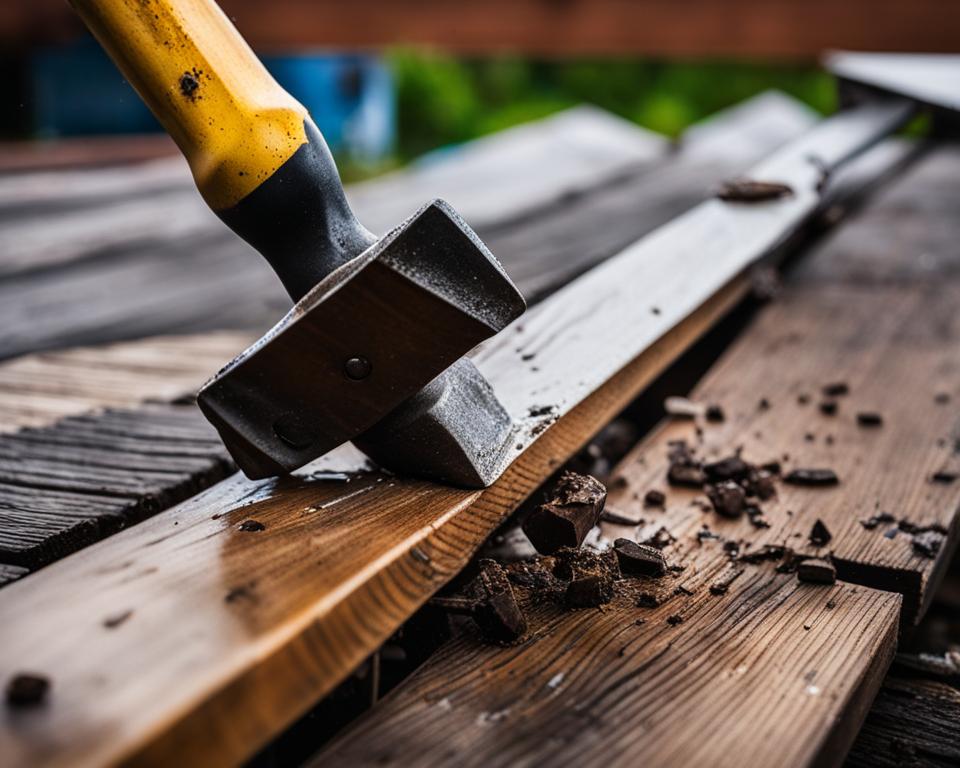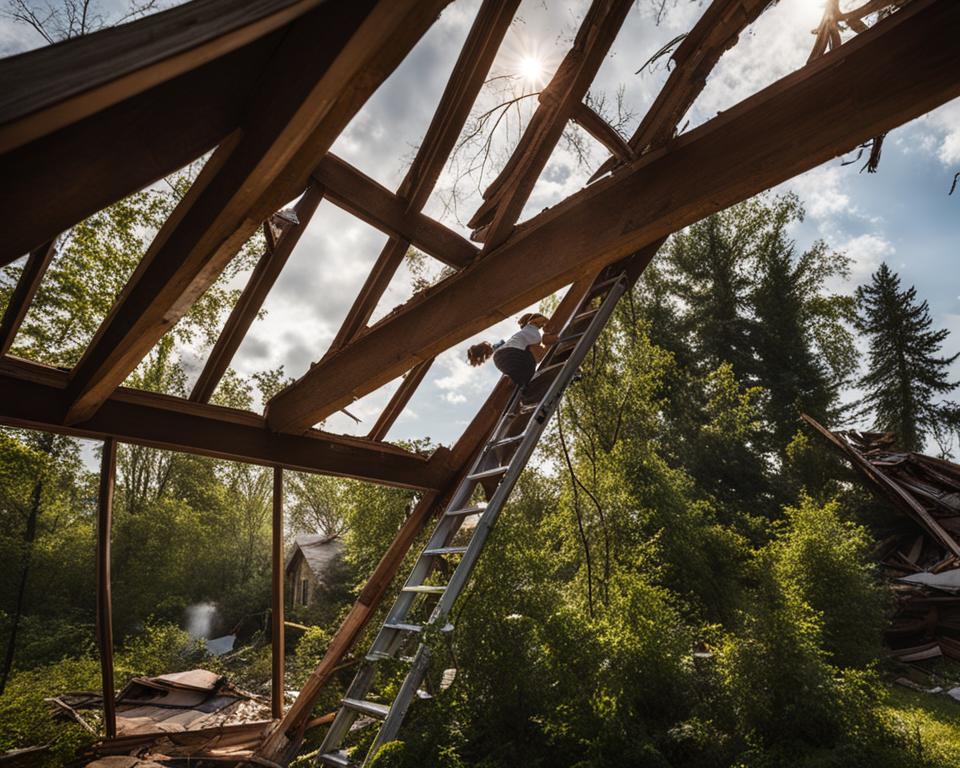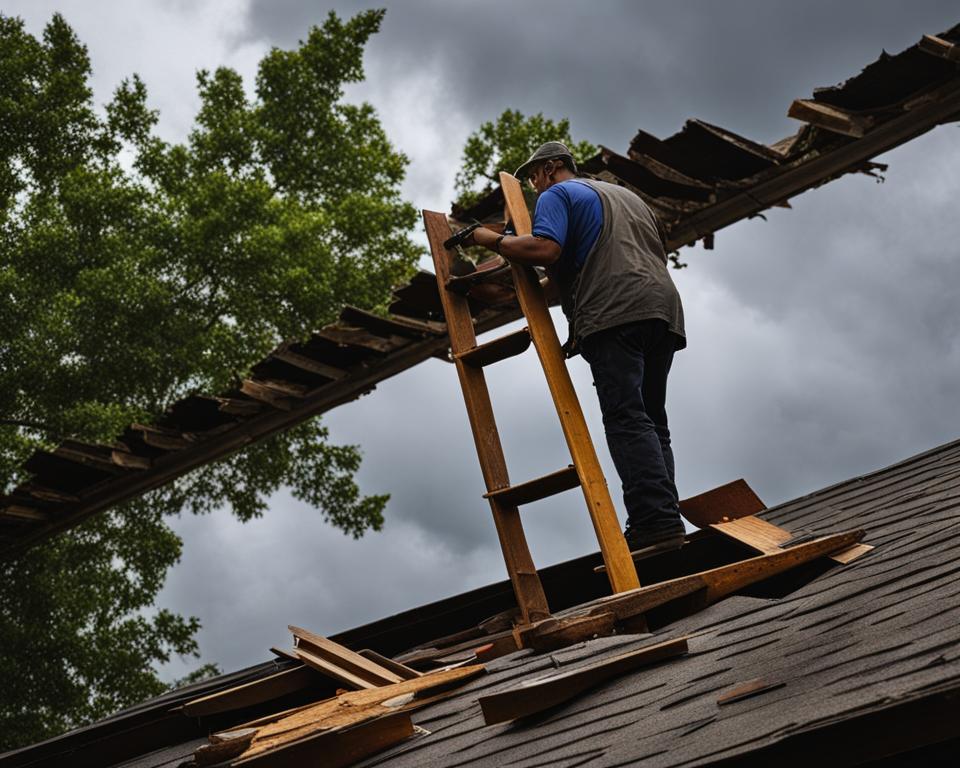Storm damage can be overwhelming and expensive to repair. However, with the right techniques and guidance, you can tackle the repairs yourself and save time and money. In this DIY guide, we will provide you with step-by-step instructions and tips for effectively repairing storm damage to your home.
Key Takeaways:
- Assess the extent of the storm damage before starting repairs.
- Hire a professional for more extensive repairs to ensure safety and quality.
- Clean up debris and fix minor damages yourself to prevent further issues.
- Document all damage and repairs for insurance purposes.
- Choose a reputable contractor for professional and efficient repairs.
- Take advantage of additional resources and support for DIY repairs.
Assessing the Damage
Before proceeding with DIY storm damage repairs, it is crucial to thoroughly assess the extent of the damage. This will help you prioritize tasks and determine if you need professional assistance. Start by ensuring your safety by checking for any potential hazards, such as downed power lines or unstable trees. If there are safety concerns, contact the appropriate authorities or professionals for help.
Once you have confirmed your safety, inspect the exterior of your home, paying close attention to areas that are most susceptible to storm damage, such as the roof, siding, and windows. Look for any signs of exterior damage, including missing or damaged shingles, dents in gutters, cracked windows, or sagging siding. Take note of any structural issues that may compromise the integrity of your home.
If you suspect roof damage, it is best to call a professional for a thorough assessment. They have the expertise and equipment to properly evaluate the condition of your roof and identify any hidden damage that may not be immediately apparent. This will ensure that all necessary repairs are addressed, reducing the risk of future issues.
By taking the time to assess the damage accurately, you can make informed decisions about which repairs you can handle yourself and when to enlist the help of professionals.
| Signs of Exterior Damage | Roof Damage |
|---|---|
| – Missing or damaged shingles | – Leaks |
| – Dents in gutters | – Sagging or weakened areas |
| – Cracked or broken windows | – Dislodged or deteriorating flashing |
| – Damaged siding | – Loose or damaged roofing materials |
Repairing Storm Damage
Once you have assessed the storm damage to your home, it’s time to start the repair process. While you can handle some repairs yourself, it’s important to hire a professional for more extensive damage. They have the necessary skills, equipment, and expertise to ensure the repairs are done correctly and safely.
When it comes to DIY storm damage repairs, there are certain tasks you can tackle on your own. For example, you can fix minor damages like broken windows or loose shingles. However, for complex repairs such as structural damage or major roof repairs, it’s best to leave it to the professionals. They can provide the necessary expertise and ensure the repair work meets safety standards.
When considering professional repairs, it’s essential to choose a reputable storm damage repair service. Do thorough research and look for companies with experience in handling storm damage. Reading customer reviews and asking for references can help you make an informed decision. Additionally, request a written estimate before starting any work to ensure transparency in pricing and services.
By combining your DIY efforts with professional repairs, you can effectively restore your home after storm damage. This collaborative approach ensures that all repairs are addressed, from minor fixes to major renovations, giving you peace of mind and a safe living environment.
Steps for DIY Storm Repair
When it comes to DIY storm repairs, there are several steps you can take to restore your home and minimize further damage. By following these simple guidelines, you can effectively clean up after a storm, prevent future damage, and tackle minor repairs on your own.
DIY Storm Damage Cleanup
The first step in DIY storm repair is to clean up any debris and remove potential hazards. This includes fallen branches, leaves, and any other objects that may pose a danger. Use gloves and appropriate tools to safely clear the area, taking care to dispose of any damaged or broken items properly.
Storm Damage Prevention
Once the cleanup is complete, it’s important to take preventive measures to minimize future storm damage. Trim any overhanging branches that could potentially fall onto your home during a storm. Secure outdoor furniture, grills, and other items that could become projectiles in high winds. Additionally, make sure your gutters are clear of debris to prevent water damage.
Simple DIY Storm Damage Repairs
For minor storm damage repairs, such as broken windows or loose shingles, you can save money by doing it yourself. Replace broken windows with new ones and secure them properly. Use roofing cement or adhesive to fix loose shingles and prevent further damage. However, if the damage is extensive or involves structural issues, it’s best to hire a professional to ensure the repairs are done correctly and safely.

| DIY Storm Repair Resources |
|---|
| 1. Online tutorials and guides for specific repair tasks |
| 2. Local hardware stores for necessary tools and materials |
| 3. Community organizations or government agencies that provide disaster assistance |
Documenting and Filing a Claim
When it comes to repairing storm damage, documenting the extent of the damage is essential for filing an insurance claim. Start by taking photographs of the affected areas, capturing the details of the destruction caused by the storm. Be sure to include close-up shots as well as wide-angle views to provide a comprehensive visual record. Additionally, make a detailed written inventory of the damages, noting any structural issues, broken windows, or water leaks.
Alongside documenting the damage, it’s crucial to keep records of any repairs performed. This includes receipts for materials purchased and invoices from contractors hired to fix the damage. These records will serve as supporting evidence for your insurance claim, demonstrating the expenses incurred as a result of the storm.
Gathering Documentation:
- Take photographs of the damage – be thorough and capture as many angles and details as possible.
- Create a written inventory of the damages, noting specific areas and items affected.
- Keep records of all repairs made, including receipts and invoices.

Once you have gathered all the necessary documentation, contact your insurance provider promptly to start the claims process. Provide them with the photographs, written inventory, and repair records to support your claim. It’s important to act quickly, as most insurance policies have specific time limits for reporting and filing claims.
During the claims process, be prepared to answer any additional questions from your insurance company and provide any further documentation they may request. It’s crucial to maintain open communication and follow up regularly to ensure a smooth and timely resolution to your claim.
Key points:
- Photograph the damage and create a written inventory of damages.
- Keep records of all repairs made, including receipts and invoices.
- Contact your insurance provider promptly to start the claims process, and provide them with the necessary documentation.
| Documenting Storm Damage | Filing an Insurance Claim |
|---|---|
| Take detailed photographs of the damage. | Contact your insurance provider promptly. |
| Create a written inventory of the damages. | Provide the insurance company with photographs and written documentation. |
| Keep records of all repairs made. | Be prepared to answer additional questions and provide further documentation if requested. |
Choosing the Right Contractor
When it comes to storm damage repairs, hiring a reputable contractor can make all the difference. With so many storm damage repair services available, it’s important to do your due diligence and choose a contractor who is experienced, reliable, and trustworthy.
Start by researching contractors in your area who specialize in storm damage repairs. Look for contractors with a proven track record and positive customer reviews. It’s also a good idea to ask for references and reach out to previous clients to get their feedback on the contractor’s work.
Once you have narrowed down your options, schedule consultations with a few contractors. During these meetings, ask about their experience with storm damage repairs and their approach to the specific repairs needed for your home. It’s also important to get a written estimate detailing the scope of work and the associated costs.
By taking the time to choose the right contractor, you can have peace of mind knowing that your storm damage repairs will be handled by professionals who will deliver high-quality workmanship and ensure the longevity of your home’s repairs.
Additional Tips and Resources
When it comes to storm damage restoration, there are a few additional tips and resources that can help you along the way. First and foremost, safety should always be your top priority. Make sure to wear protective gear, such as gloves and goggles, when handling debris or performing repairs.
Utilize Online Resources and Tutorials
There are numerous online resources and tutorials available that can provide you with step-by-step instructions for specific storm damage repairs. From fixing a leaky roof to repairing damaged siding, these resources can offer valuable guidance and tips to help you tackle the repairs effectively.
Consider Disaster Assistance Programs
If the storm damage to your home is extensive, you may qualify for disaster assistance programs offered by organizations or government agencies. These programs can provide financial support or resources to help you with the restoration process. Contact your local authorities or research online to see if you are eligible for any assistance.
Take Preventive Measures
While it’s important to address the existing storm damage, it’s equally crucial to take preventive measures to protect your home from future storms. Trim any overhanging branches or trees that could potentially cause damage during a storm. Secure outdoor items, such as patio furniture or garden equipment, to prevent them from becoming projectiles in high winds. It’s always better to be prepared and prevent damage before it occurs.
By utilizing these additional tips and resources, you can enhance your DIY storm damage repairs and ensure a successful restoration process. Remember to prioritize safety, seek assistance when needed, and take preventive measures to minimize future damage.
FAQ
How do I assess the extent of storm damage to my home?
Start by checking for any potential hazards, such as downed power lines or unstable trees. Once you have ensured your safety, inspect the exterior of your home, including the roof, siding, and windows. Take note of any missing or damaged shingles, dents in gutters, or cracked windows. If you suspect roof damage, it is best to call a professional for a thorough assessment.
Should I hire a professional for storm damage repairs?
While you can handle some repairs yourself, it’s important to hire a professional for more extensive repairs. They have the necessary equipment and expertise to ensure the repairs are done correctly and safely. There are many storm damage repair services available, so be sure to do your research and choose a reputable and experienced one.
What steps can I take for DIY storm repairs?
Start by cleaning up any debris and removing potential hazards. Fix any minor damages, such as broken windows or loose shingles, yourself. Also, take preventive measures to minimize future storm damage, such as trimming trees and securing outdoor items. These simple DIY repairs can make a big difference in preventing further damage.
How should I document storm damage for insurance purposes?
It’s important to document all storm damage with photographs and keep records of any repairs you make. This information will be valuable when filing an insurance claim. Contact your insurance provider as soon as possible and provide them with the necessary documentation. Keep receipts of any expenses related to the repairs, as they may be reimbursable. Acting quickly and efficiently can help ensure a smoother claims process.
How do I choose the right contractor for storm damage repairs?
Research and look for contractors with experience in repairing storm damage and positive customer reviews. Ask for references and get a written estimate before starting any work. Choosing a reputable and reliable contractor will ensure that the repairs are done professionally and efficiently.
Are there any additional tips and resources for DIY storm damage repairs?
Consider contacting organizations or government agencies that provide disaster assistance for additional support. Take advantage of online resources and tutorials for specific repair tasks. By using all available resources and following these DIY tips, you can successfully restore your home after storm damage.

Leave a Reply